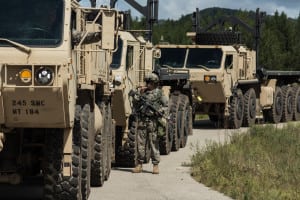The Army’s lack of reliable communication with vendors is hindering its ability to grow its tactical wheeled vehicle (TWV) industrial base and increase competition, according to a new Government Accountability Office (GAO) report.
The report arrives as the Army is set to release a new TWV modernization strategy next year, its first since 2014, with GAO also recommending that the service routinely update that plan to ensure its fleet can best take advantage of industry’s advancements and avoid obsolescence.

“Without taking steps to improve its communication with industry, the Army could miss opportunities to increase companies’ participation in TWV modernization efforts, facilitate competition, and benefit the taxpayer and the warfighter,” the GAO wrote in its report.
The 2022 TWV modernization strategy is expected to detail future requirements to ensure the fleet, which includes the Oshkosh Defense [OSK]-built Joint Light Tactical Vehicle, Humvees, the new Infantry Squad Vehicle manufactured by GM Defense [GM] and FMTV and HEMTT trucks, is best suited for future multi-domain operations (MDO).
GAO notes it spoke to commercial vendors and trade associations in the truck space who noted the market is expanding, but there are challenges in working with the Army in terms of inconsistent communication on desired capability requirements.
“For example, industry officials noted that, in the past, the Army has communicated the need for improved capabilities, which causes the companies to then expend their own funds. When the Army chose not to pursue these capabilities, the companies then lost their investment and thus were less likely to be involved in future efforts,” the GAO wrote. “Leveraging additional companies’ commercial technology advancements could facilitate competition or potentially reduce the cost of the vehicles the Army needs as well as the cost of developing new capabilities.”
The report also states that 22 of the Army’s 37 active TWV contracts over the last six fiscal years were non-competitive deals, noting the Army did acknowledge it will look to consider “multiple ways to facilitate competition for future awards” to include “acquiring technical data for new production contracts and expanding the use of consortia other transaction agreements for development.”
For JLTV, which is the Joint Light Tactical Vehicle, where the Army owns the technical data package, the service is set to competitively award a follow-on production deal next year as it looks to further drive down production costs while deviating as little as possible from the current vehicle design.
The JLTV re-compete effort has drawn at least one other public competitor beyond Oshkosh, with GM Defense detailing plans to line up partners and ensure it has the full supply chain of parts necessary to go after the production contract (Defense Daily, May 4).
The follow-on production deal for JLTV is expected to be a 10-year contract valued at about $12.3 billion, according to GAO.
While the Army has no policy to regularly update its TWV strategy, GAO suggests that officials should increase transparency on its plans for modernizing and managing the fleet with more routine public updates.
“If, however, the Army does not routinely update the TWV strategy to consider information that is developed over time from other initiatives, the service risks using outdated and incomplete information to manage its fleet of TWVs,” the report states. “This is especially the case if the Army does not take into account any new TWV capabilities identified for MDO or developed in ongoing research programs. If this information is not routinely updated it could affect Congress’s ability to make informed decisions.”
Army officials have previously said the new TWV strategy is likely to include plans for future JLTV deliveries, developing an Enhanced Heavy Equipment Transporter System, modernizing its Family of Medium Tactical Vehicles (FMTVs) and going after advanced Leader-Follower autonomy capabilities (Defense Daily, Feb. 5 2019).